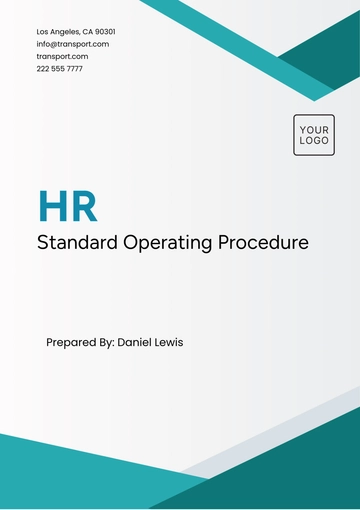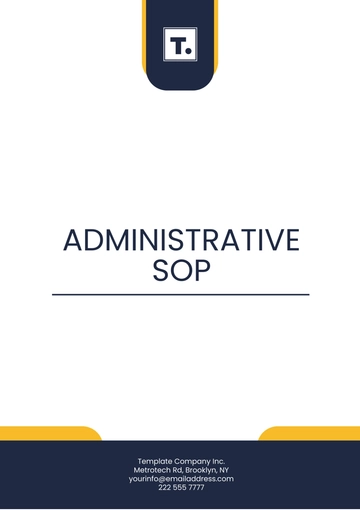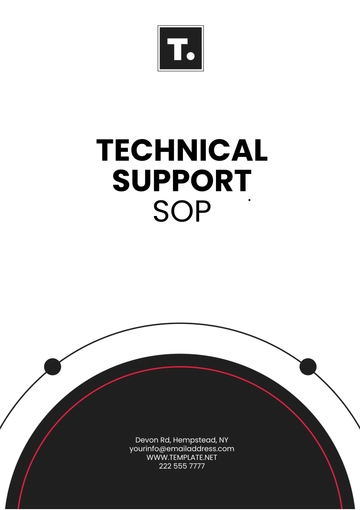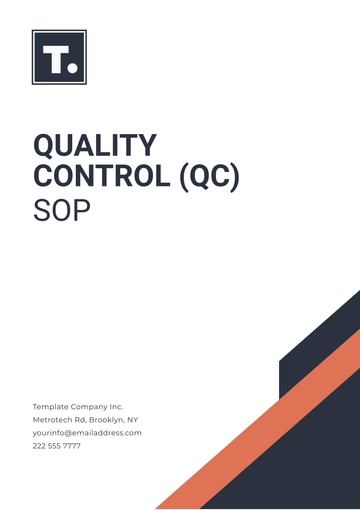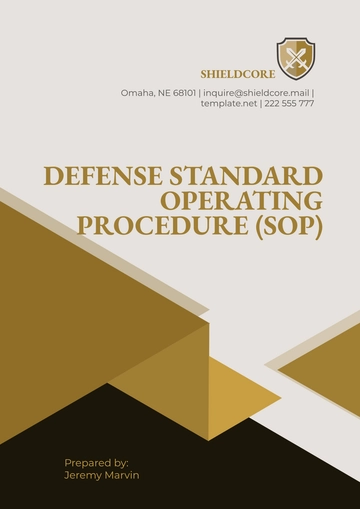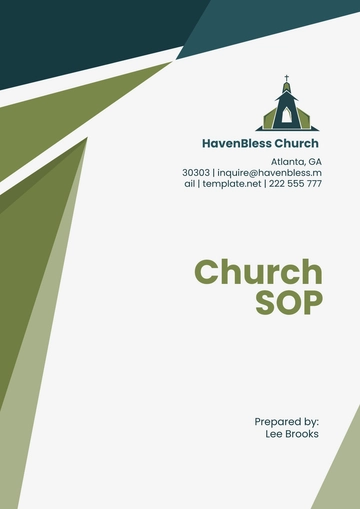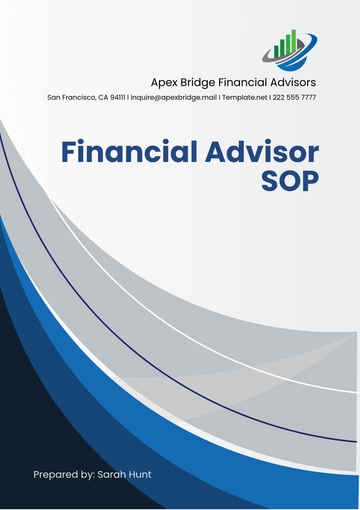Free Financial Investment SOP
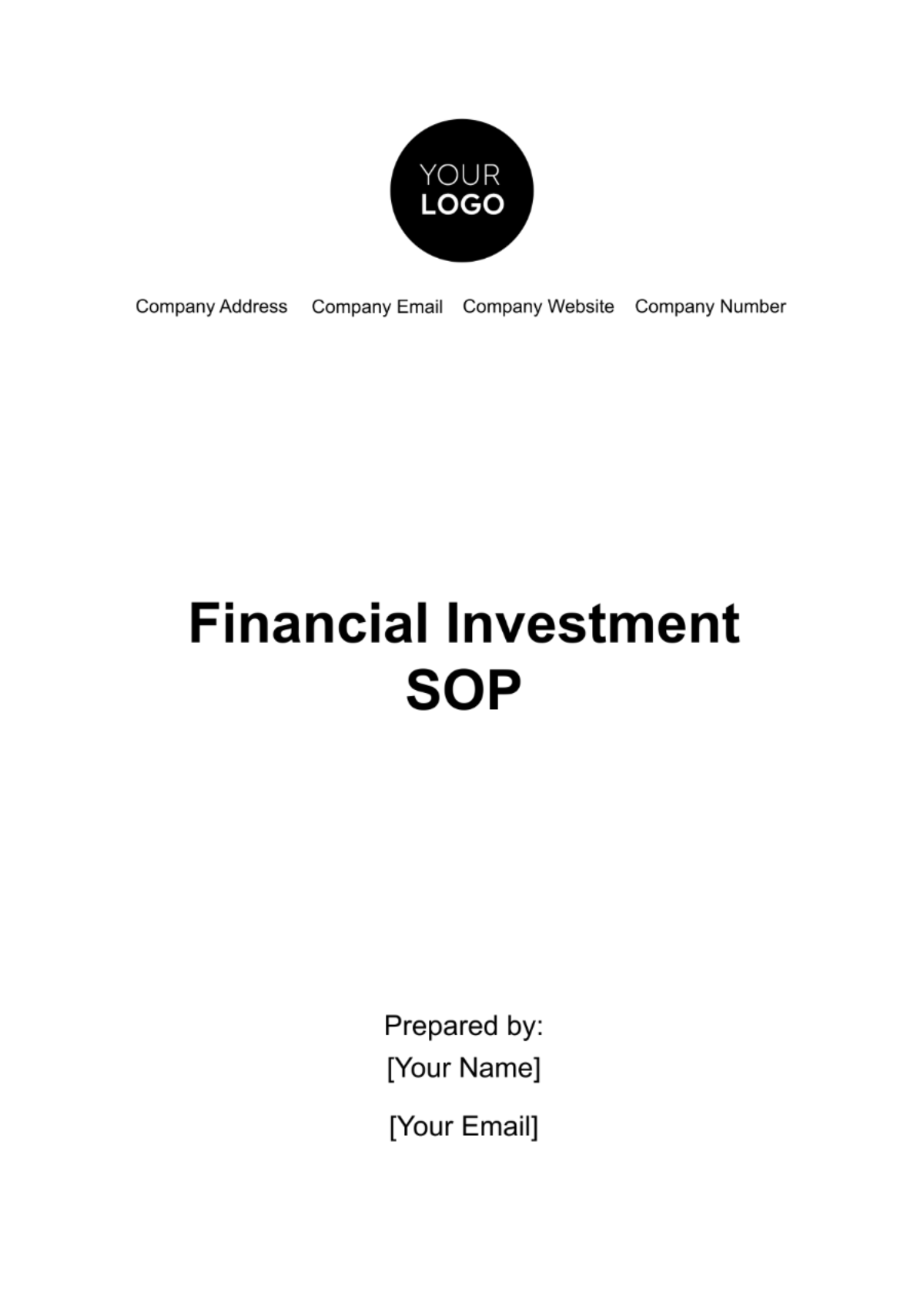
Introduction
The purpose of this Standard Operating Procedure (SOP) is to provide a systematic and consistent approach to our investment activities. It is designed to guide our team in making informed and effective investment decisions, ensuring that all operations are carried out in a manner that is in line with our strategic objectives, risk management framework, and regulatory requirements. This SOP serves as a blueprint for managing our investment portfolio, detailing processes from initial analysis to execution and ongoing management.
Scope and Applicability
This SOP applies to all investment activities conducted by our team. It is intended to be used by our investment committee, portfolio managers, analysts, and any other staff involved in the investment decision-making and management process. The procedures outlined in this document cover a range of investment operations including, but not limited to, asset selection, risk assessment, portfolio management, compliance, and reporting.
Definitions of Key Terms
Investment Committee: The group responsible for overseeing the investment strategy and making key investment decisions.
Portfolio Manager: An individual responsible for managing the investment portfolio in accordance with the established strategy and objectives.
Asset Allocation: The process of distributing investments among various asset classes, such as stocks, bonds, and cash.
Risk Tolerance: The degree of variability in investment returns that an investor is willing to withstand.
Compliance: Adherence to laws, regulations, guidelines, and specifications relevant to investment activities.
Investment Policy Statement
Our investment policy is crafted to manage assets responsibly and effectively, with the aim of achieving optimal returns consistent with our risk tolerance and investment objectives. The policy outlines our approach to asset allocation, risk management, and portfolio diversification, and serves as a guiding framework for all investment decisions and operations.
Investment Goals and Objectives
Capital Preservation: Ensuring the protection of principal over the long term.
Income Generation: Achieving a steady stream of income through dividends and interest.
Growth: Capital appreciation of assets over time.
Liquidity: Maintaining sufficient liquidity to meet operational needs and take advantage of new investment opportunities.
Risk Tolerance and Asset Allocation Strategy
We have a balanced risk tolerance, seeking a compromise between risk and return to achieve moderate growth with controlled exposure to risk.
Equities: 40-50% - For growth and capital appreciation.
Fixed Income: 30-40% - For income generation and risk mitigation.
Alternatives: 10-15% - For diversification and potential for higher returns.
Cash and Equivalents: 5-10% - For liquidity and safety.
Roles and Responsibilities
This section delineates the specific roles and responsibilities within our investment process, ensuring clarity and accountability at each stage of our operations. A well-defined structure is crucial for efficient decision-making, compliance, and achieving our investment objectives.
Role | Responsibilities |
Investment Committee |
|
Chief Investment Officer (CIO) |
|
Portfolio Managers |
|
Risk Management Officer |
|
Compliance Officer |
|
Financial Analysts |
|
Each role within our team is critical to the effective management of our investment operations. By clearly outlining these responsibilities, we ensure that every team member understands their contribution to our collective investment goals.
Investment Selection and Criteria Process
This section elucidates our methodical approach to selecting individual investments, which is critical for achieving our investment objectives. Our process is characterized by stringent criteria, thorough due diligence, and ongoing monitoring to ensure each investment aligns with our strategic goals.
Criteria for Selecting Individual Investments
Does the investment meet our risk-return profile and investment goals?
Is there strong potential for growth or income in the market or sector of the investment?
Does the entity show strong financial performance and stability?
Is the entity's management team experienced and credible?
Does the investment have a sustainable competitive advantage in its market?
Is the investment priced attractively relative to its intrinsic value?
Can the investment be readily bought or sold without a significant price concession?
Is the investment compliant with relevant regulations and laws?
Does the investment meet our environmental, social, and governance criteria?
Due Diligence Process
Assess investment against the selection checklist.
Conduct detailed financial, operational, and strategic analysis.
Evaluate specific risks associated with the investment.
Ensure regulatory and legal compliance.
Engage external experts for specialized assessments, if necessary.
Present findings to the investment committee for deliberation.
Approval or rejection of the investment proposal.
Ongoing Monitoring and Review Procedures
Regularly measure investment performance against benchmarks and expectations.
Continuously monitor market and economic conditions for potential impacts on the investment.
Periodically reassess the risks associated with the investment.
Ensure ongoing regulatory compliance of the investment.
Provide regular updates to stakeholders on the investment's performance and any significant changes.
Risk Management Procedures
This section outlines our comprehensive procedures for managing investment risks, a critical aspect of our overall investment strategy. Our approach to risk management is proactive, aiming to identify, assess, and mitigate various investment risks to safeguard our portfolio's performance and stability.
Risk | Mitigation Strategies |
Fluctuations in market prices and conditions. | Diversification across asset classes and sectors; use of hedging instruments like options and futures. |
The risk of loss due to a borrower's failure to make payments. | Thorough credit analysis; investing in high-credit-quality assets; diversification of credit exposures. |
The risk of being unable to sell an asset without a significant price impact. | Maintaining a portion of the portfolio in highly liquid assets; regular liquidity stress testing. |
Risks arising from operational failures or inadequacies. | Implementation of strong internal controls; regular audits and process reviews; staff training programs. |
The risk of investment value changes due to interest rate fluctuations. | Duration management in fixed-income investments; strategic use of fixed and floating rate securities. |
Risks associated with political changes or instability in investment regions. | Geographic diversification; continuous monitoring of political developments; flexible investment strategies. |
Changes in laws or regulations that could impact investments. | Ongoing compliance monitoring; adapting investment strategies to regulatory changes. |
Risk of loss from fluctuations in foreign exchange rates. | Currency hedging through forwards and options; currency diversification; investing in currency-neutral assets. |
Portfolio Management Guidelines
In this section, we outline the guidelines for portfolio management, focusing on asset allocation, diversification, and rebalancing procedures. These guidelines are crucial for maintaining a portfolio that aligns with our investment objectives and risk profile.
Asset Allocation and Diversification Guidelines
Strategic Asset Allocation: Our asset allocation is guided by a long-term perspective, aligning with our investment objectives and risk tolerance. It involves distributing investments across various asset classes such as equities, fixed income, alternatives, and cash.
Diversification: We diversify investments within each asset class and across different sectors and geographies. This approach is designed to spread risk and capitalize on growth opportunities in different market segments.
Tactical Adjustments: While maintaining our strategic allocation, we may make tactical adjustments in response to short-term market movements or changes in economic outlook.
Rebalancing Procedures
Our portfolio is reviewed and rebalanced on a semi-annual basis, or more frequently if significant market movements occur. If any asset class’s allocation deviates more than a predetermined percentage from its target allocation, we initiate rebalancing to realign the portfolio. Rebalancing is achieved by either buying or selling assets, or by using cash flows (like dividends or interest payments) to adjust the portfolio composition.
Performance Benchmarks and Review Intervals
Asset Class | Performance Benchmark | Review Interval |
Equities | S&P 500 | Quarterly |
Fixed Income | Bloomberg Barclays US Aggregate Bond Index | Quarterly |
Overall | Weighted average of the asset class benchmarks | Semi-annually |
Compliance and Regulatory Adherence
This section emphasizes the importance of compliance and adherence to regulatory standards in our investment activities. We are committed to maintaining the highest standards of legal and regulatory compliance to ensure the integrity and credibility of our operations.
Compliance with Relevant Laws and Regulations
Regular Updates: Staying abreast of and understanding all applicable laws, regulations, and industry standards that impact our investment activities.
Application: Ensuring that all investment decisions and operations comply with the relevant financial and securities regulations.
External Advisors: Consulting with legal and regulatory experts to gain clarity and guidance on complex compliance matters.
Internal Compliance Procedures
Compliance Training: Regular training programs for all staff members to educate them about their compliance responsibilities.
Internal Audits: Conducting periodic internal audits to review and ensure adherence to compliance policies and procedures.
Compliance Monitoring: Continuous monitoring of investment activities for any potential compliance issues or deviations.
Reporting and Documentation Requirements
Documentation: Maintaining detailed and accurate records of all investment decisions, transactions, and compliance efforts.
Reporting: Regular reporting to regulatory bodies as required, including disclosures of potential conflicts of interest or other compliance matters.
Internal Reporting: Providing regular compliance reports to the management and investment committee.
Operational Procedures
In this section, we detail the operational procedures that underpin our investment activities, ensuring efficiency, accuracy, and accountability in our daily operations. These procedures are essential for the smooth execution of our investment strategies.
Order Placement
Confirm the details of the order, including asset type, quantity, price, and trade date.
Obtain the necessary approvals from authorized personnel based on investment policy.
Place the order through a designated broker or trading platform.
Receive and verify trade confirmation from the broker or exchange.
Trade Settlement
Ensure the details of the trade match with the counterparty.
Send or receive instructions to or from the custodian or settlement agency.
Arrange for the transfer of funds to settle the purchase or receipt of funds for a sale.
Confirm the completion of the settlement process and update records.
Execution Oversight
Continuously monitor trade execution for discrepancies or deviations from expected outcomes.
Ensure that trades comply with internal guidelines and external regulatory requirements.
Quickly identify any execution issues, such as missed trades or price discrepancies.
Address any issues promptly and report to relevant authorities if necessary.
Documentation
Maintain comprehensive records of all trade details, including order, execution, and settlement documentation.
File documents systematically for easy retrieval and reference.
Ensure that all documents are securely stored to protect sensitive information.
Keep all documentation up to date with any changes or amendments.
Data Management
Collect relevant data from various sources, including trade execution, market data, and internal records.
Process and organize data for analysis and reporting.
Store data securely with appropriate backup and recovery systems.
Ensure easy access to data for authorized personnel.
Audit Trail
Record all transactions in detail, including the date, time, parties involved, and nature of the transaction.
Maintain logs of all changes made to investment positions or strategies.
Keep logs of who accessed which data and when, especially for sensitive information.
Regularly review and verify the audit trail for accuracy and completeness.
Handling of Exceptions and Anomalies
Promptly identify any exceptions or anomalies in the investment process.
Investigate the cause and assess the impact of the exception or anomaly.
Implement appropriate measures to resolve the issue.
Escalate significant issues to higher management for further action.
Document the exception, investigation, resolution, and any escalation process.
Performance Measurement and Reporting
This section outlines our approach to performance measurement and reporting, which is crucial for evaluating the success of our investment strategies and making informed decisions. We utilize a range of methods and metrics to comprehensively assess and report on our investment performance.
Performance Evaluation Methods
Benchmark Comparison
Absolute and Relative Performance Analysis
Risk-Adjusted Return Metrics
Reporting Format and Frequency
Report Type | Frequency | Description |
Portfolio Performance Report | Quarterly | Detailed analysis of performance, benchmark comparison, and risk metrics. |
Compliance and Risk Report | Bi-annually | Review of compliance status and risk profile changes. |
KPIs and Performance Benchmarks
KPI | Benchmark | Description |
Alpha | - | Measures the portfolio's performance relative to the benchmark, accounting for risk. |
Beta | Market Index (e.g., S&P 500) | Indicates the portfolio's volatility compared to the market. |
Sharpe Ratio | Risk-Free Rate | Assesses the performance of the portfolio by adjusting for its risk. |
Review and Update of SOP
This final section specifies the procedures for regularly reviewing and updating the SOP to ensure it remains effective and relevant. Regular revisions are crucial to adapt to evolving market conditions, regulatory changes, and organizational needs.
Schedule for Regular Reviews and Updates
Review Type | Frequency | Description |
Comprehensive SOP Review | Annually | Full review of the SOP to ensure relevance and effectiveness. |
Tactical SOP Update | As needed | Updates in response to significant changes in market conditions or regulations. |
Process for Making Amendments
Identification of the need for an amendment.
Gathering input and feedback from relevant stakeholders.
Proposed changes are drafted, detailing the reasons and expected impacts.
The draft amendments are reviewed by authorized personnel for approval.
Approved changes are implemented, and the updated SOP is communicated to all.
All amendments are documented, including the rationale and the date of implementation.
- 100% Customizable, free editor
- Access 1 Million+ Templates, photo’s & graphics
- Download or share as a template
- Click and replace photos, graphics, text, backgrounds
- Resize, crop, AI write & more
- Access advanced editor
The Financial Investment SOP Template from Template.net is a meticulously designed tool, essential for standardizing investment processes. Editable and customizable in our AI Editor tool, it aids in creating detailed Standard Operating Procedures for financial investments. This template ensures consistency and clarity in investment practices, making it invaluable for financial institutions and individual investors seeking structured and efficient investment methodologies.





